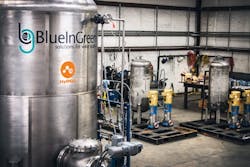Disinfection: Ozone Injection for Dependable Disinfection
In early 2013, initial planning and design began for the Clarksville Light & Water (CLW) drinking water treatment plant expansion project in Clarksville, Ark. CLW became the first treatment plant in the state to utilize ozone in 1993 and currently serves approximately 28,000 people, consisting of residential, industrial and commercial users. The $10 million design-build expansion will allow the plant to increase the maximum output capacity from 12 to 16 million gal per day (mgd). In addition, the project will accommodate regional population growth by preparing the city’s infrastructure to meet a future plant capacity of 24 mgd.
Prior to the 16-mgd renovations, the facility operated a pre-sedimentation venturi ozone sidestream injection system with additional ozone added via bubble diffusers post-sedimentation. The final design of the plant was to include biologically active filters with an upgrade to the pre-sedimentation ozone injection system. To determine the dose required for the larger flow rates, an ozone demand/decay test was performed alongside contact time (CT) calculations to achieve 0.5-log Cryptosporidium reductions at temperatures ranging from 0 to 25°C.
In Search of Ozone Injection
With the design requirements in mind, CLW—with the assistance of engineering design firm McGoodwin, Williams & Yates—researched alternatives for the facility’s pre-sedimentation ozone injection system. As part of its 2002 upgrade from 8 to 12 mgd, the plant had previously added two Ozonia ozone generators, capable of producing a total of 425 lb per day of ozone at a concentration of 6% by weight. To keep capital costs down, the generators were used in sizing of the new injection system. Because the Ozonia generators were not tied to the plant’s SCADA system, the ability of the injection system to control the ozone dose was a primary objective.
Plant managers at CLW ultimately selected BlueInGreen’s HyDOZ ozone injection system as part of the facility’s design-build 16-mgd expansion project. The system injects a sidestream of water through a saturation vessel to elevate the pressure at which the ozone gas is dissolved, allowing for higher concentrations of ozone at lower flow rates. The skid-mounted system allowed for simple installation, and the single-water inlet and outlet reduced installation and capital expenses for the contractor. Because of the existing ozone generators’ pressure and concentration output limitations, the HyDOZ injection skid was sized larger than what would typically be seen with new installations. However, with plant upgrades anticipated in the future, new generators are expected to provide upwards of 10% weight at a greater pressure than the current operations allow. With the increased ozone output, the current HyDOZ system is expected to meet the plant’s disinfection requirements up to 24 mgd.
“The HyDOZ stood out as the most convenient and cost-effective solution for Clarksville Light & Water,” said Roy Young, plant manager. “Ultimately, this project was designed with Clarksville’s continued growth in mind by having the HyDOZ sized to accommodate capacity needs for both today and in the future.”
Construction and installation of the plant renovations began in late 2014 with the inaugural ozone injection system starting up June 2015. To accommodate the need for ozone dose control, the injection system offers two operating modes to allow for flexible, hands-free functionality. The first setting, Disinfection Mode, provides automatic control of CT values based on the operator’s predetermined setpoint and feedback signals from three dissolved ozone meters. With this information, the HyDOZ can internally calculate the integrated CT value and adjust output to meet the setpoint. The second setting, Residual Mode, allows control of a single dissolved ozone meter, simplifying treatment and providing redundancy in the event of plant flow signal loss, which is required for the CT calculation. These control modes, along with the system’s wireless capability, allow operators to monitor and manage the system from laptops, cell phones and tablets, providing CLW’s relatively small staff the ability to control its ozone system even when operators are not on site.
The first HyDOZ installation was not without its trials. After working through a few minor issues during construction and startup—with the help of the CLW staff and the team at McGoodwin, Williams & Yates—the ozone system now is performing as planned, demonstrating ozone injection efficiencies upwards of 98%, while allowing the plant to meet its disinfection requirements.
Download: Here
